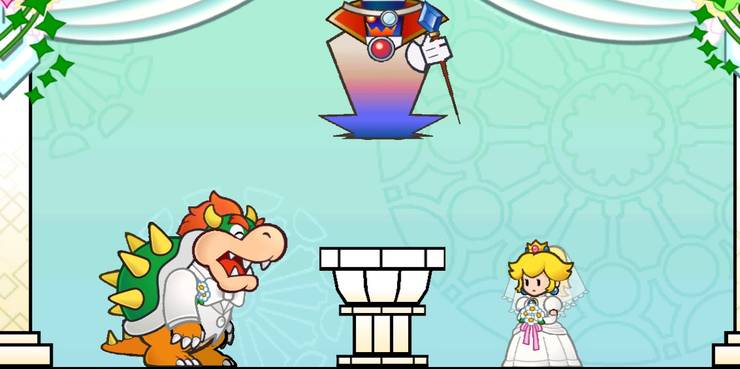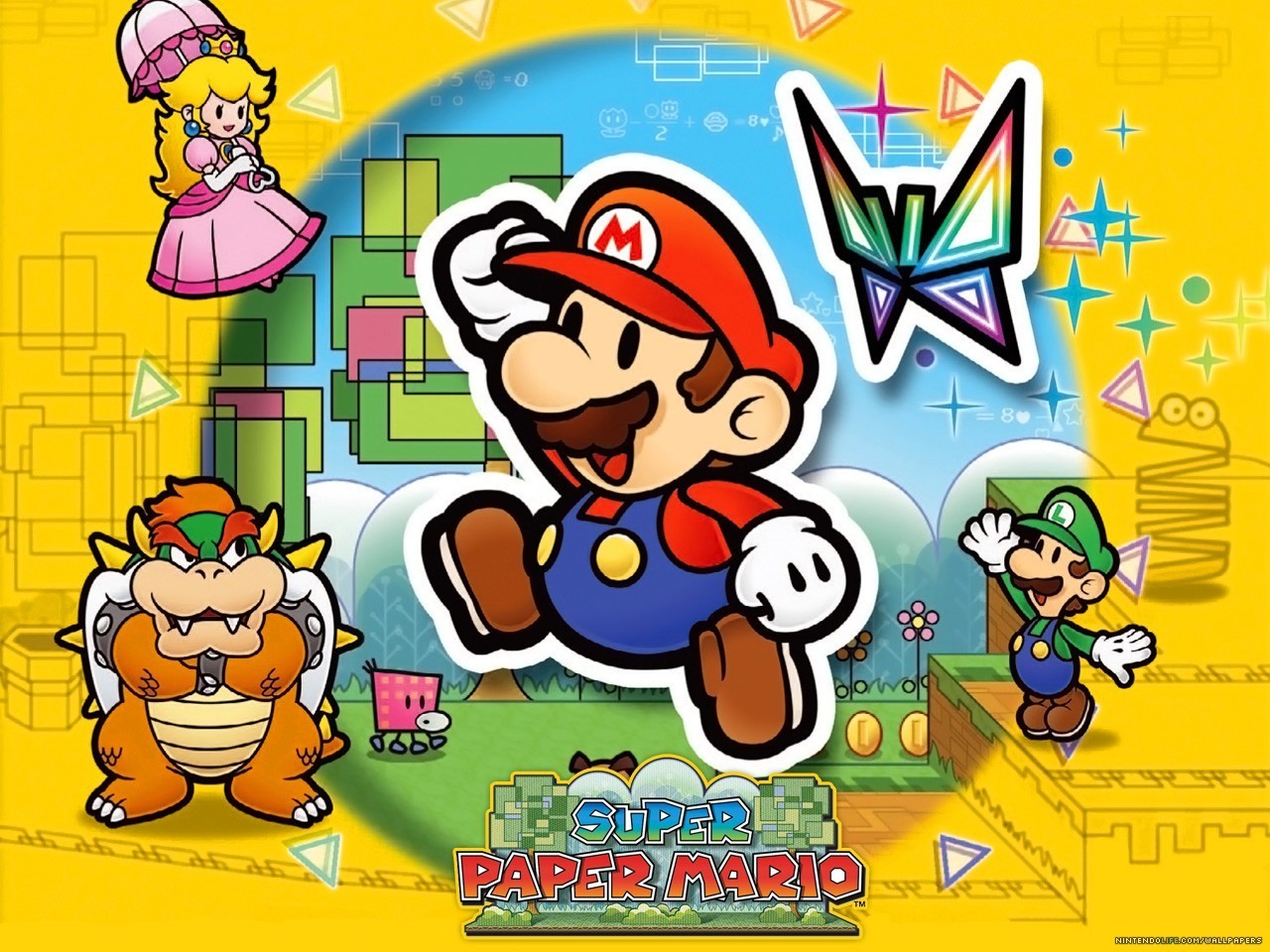For the final piece in my series of retrospectives of the Paper Mario series, I look at the 2007 game, Super Paper Mario. It came out for the Nintendo Wii and it is the third game in the series. While it is a sequel to Paper Mario: The Thousand-Year Door, Super Paper Mario is a very different game. Instead of flat characters in a 3-D world like the previous two games, the whole world is flat and Mario gains the ability to flip between 2-D and 3-D. Also, the game is not a turn-based RPG like the previous two games as Super Paper Mario is a platform-based game with RPG elements. I enjoy Super Paper Mario as the game’s story, humor and characters are done well with amazing worlds set up. However, the quality of the gameplay takes a nosedive compared to its predecessors and the battle system, the enemy layouts and the boss battles are mediocre at best.

The game has a strong story. There is a book called the “Dark Prognosticus,” a book of power that can give the reader knowledge on how to bring about “the end of all worlds.” Count Bleck wields this book and kidnaps Princess Peach and Bowser to prepare a wedding. Once Peach agrees to marry Bowser under hypnosis, the Chaos Heart is unleashed, creating a dark void that will devour worlds as it grows.
The eight pure hearts are the only objects that can banish the Chaos Heart. After receiving the first pure heart, Mario and his companion Pixl, Tippi, set out to collect the the other seven. They are spread across seven different worlds, or dimensions in this game. Peach, Bowser and Luigi all escape from the clutches of Bleck and team up with Mario and Tippi to collect the Pure Hearts. Along the way, Mario and party must outduel Bleck’s minions and other challenging foes to save the world once again.

The story is a strong aspect of this game. Due to the increasing size of the void in the background of every world, the urgency to save the world feels genuine. There are multiple twists in the story that make it interesting and correspond with a lot of heartwarming and heartbreaking moments. The story is packed with emotion and well-developed characters, making the events of the game more impactful.
The characters also keep the story engaging. With interludes between each chapter, various minions are developed, something the first two games barely did. Bleck’s minions, O’Chunks, Mimi and Dimentio are all developed, and it was nice to see a villain other than the main one receiving development. As for the heroes, I love having Mario, Peach, Bowser and Luigi as playable characters in the adventure. It spices up the gaming experience and allows us to follow the story through multiple perspectives.

The worlds built for this game not only worked for the story but also looked great too. Like the first two games, this game had many unique worlds. With the worlds being dimensions in this game, the developers had more freedom to create a variety of settings. Some of these include a land made up only of bits, outer space and a cave full of living flowers. I enjoyed the different landscapes the game made and that added to the greatness of the story.

One aspect I did not touch on in the first two games was the writing. In those games, they were fine. In Super Paper Mario, the writing was exceptional and hilarious. This game felt like a love letter to geeks and nerds everywhere and there is no better example of this than in chapter three. There you meet Francis, a chameleon nerd who collects comics, video games, TV shows and action figures while posting on internet discussion boards. There is also a monster that talks like a literal computer during the mid 2000s. The game has many hilarious lines of dialogue and even pokes fun at the Mario universe. This includes the four main characters, such as making fun of Bowser always kidnapping Peach and Mario always rescuing her.
That is where I halt on the positives. While I enjoy this game, Super Paper Mario has its faults, especially in its gameplay. The first two games were all about turn-based combat with an emphasis on strategy. In this game, it is all about attacking enemies in the field in real time, leading to clunky action. Most damage taken comes from simply bumping into enemies regardless if they are attacking, which leads to a lot of unnecessary frustration. While the case can be made this mechanic is like the original Super Mario Bros., it doesn’t work for a story-based game with so many different abilities.

Also, the enemy placement is laughable at times. In the first two games, the enemies on the road felt like a part of the world they live in. In this game, it feels like random enemies were placed to give the player things to kill. While there are enemies that make sense, most of them don’t and it lessens the immersion factor. A main example is the appearances of Clubbas, a spike soldier that attacks with a club. They appear in the original game as guardians of Tubba Blubba’s castle. They make sense there as they are hired guards for the fortress. In the Wii game, they are simply random enemies in a plain-like place and their appearance makes no sense. This is the case for many other enemies in the game.

The boss battles are also weak compared to the first two games. The first two games required a lot of strategy to beat them due to the turn-based system. Fights would be drawn out and were often challenging. For example, in the original, beating Huffin’ Puff was difficult as he would spawn mini-versions of himself every time he got hit. Then, he would proceed to swallow them to regain his HP. This required a lot of strategy to beat him and it felt rewarding when you finally do. In this game, you simply jump on or breathe fire on bosses and fights can feel either extremely tedious or pathetically easy.
Let me compare the chapter seven bosses to illustrate this point. In the first two games, the chapter seven bosses were difficult with 70 HP, two points of defense and had very strong attacks. They were difficult to beat, especially if you were under-leveled. In this game, the chapter seven boss took me 45 seconds and I used only one move. I also came into the fight a little under-leveled. This battle is a perfect example of the difference in boss quality.
However, one commonality is all three games have an amazing soundtrack. Naoko Mitome, Chika Sekigawa and Yasuhisa Baba composed the soundtrack and it was incredible. They did a great job building up the emotional moments along with the epicness of the adventure. While the gameplay was average at best, the soundtrack helped to make up for it.
Overall, Super Paper Mario is a good game with underwhelming gameplay. The characters and story are fantastic, making this game a fun experience. I only recommend this game if you care more about story than gameplay. As much as I enjoyed this game, I hope Paper Mario: The Origami King is more like the first two games. Stay tuned for my list of top-10 Paper Mario chapters.
Rating: 7/10


One thought on “A retrospective on ‘Super Paper Mario’”